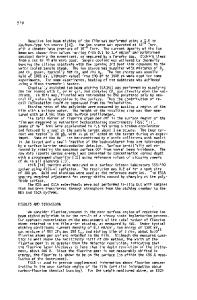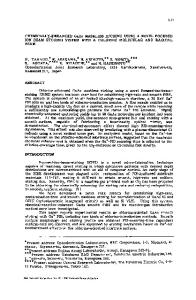Ion beam etching of polytetrafluoroethylene
- PDF / 1,429,421 Bytes
- 6 Pages / 593.28 x 841.68 pts Page_size
- 14 Downloads / 441 Views
Cross-links among long chains have been observed in ion bombarded hydrocarbon polymers like polystyrene or polyethylene. Irradiation of fhioropolymers, instead, produces a strong sample erosion with emission of fragments produced along the ion track. Polytetraf luoroethylene foils of thickness ranging from 50 fim up to 2 mm were exposed to MeV helium and proton beams. The ion erosion rate was investigated by changing the target temperature and observing surface topography modifications, using the scanning electron microscopy technique. Etching was measured as removed thickness per irradiation time in the range values of 102-104 ju,m/h, corresponding to about 104-106 CF2 emitted group/ion. Target temperature (200-400 K), ion mass, and ion energy are the key parameters to follow the evolution of ion erosion of polytetraf luoroethylene.
I. INTRODUCTION
Ion etching of fluoropolymers seems a very efficient way to produce polymer erosion and for surface treatment of biomaterials, producing microholes on the micron scale with smoothest walls and sharpest definition. Using polytetrafluoroethylene (PTFE) it is possible, for example, to fabricate microfilters for biological liquids with interesting applications in the biomedical field for sufferers of hydrocephalus, a malady which results in the buildup of cerebrospinal fluid in the brain. The perforated PTFE tubing is inserted into the ventricle and serves as a shunt by draining off the excess cerebrospinal fluid into another part of the brain, where the fluid is absorbed by normal processes.1 From the physical and chemical points of view it should be very interesting to understand the basic mechanism of the ion-polymer interaction in fluoropolymers. It is well known that electronic excitations produced by high energy ions in polymers make a profound change in the material. MeV helium ion may ionize an atom in each atomic layer it penetrates and it may break thousands of atomic bonds along its penetration track, so it can produce particular chemical reactions at high rates along its track. Polymer properties, such as density, electrical conductibility, and solubility of thin films, have been changed by ion irradiation. For example, variation in the hydrogen concentration induced by ion irradiation has been observed in the hydrogenated polymers, and a carbon enrichment is found at depths comparable with the ion range.2'3 It is well known that when polyethylene, polystyrene, and polymethylmetacrylate film are ion irradiated, the dominant induced reaction is a chain cross-link with consequent increasing of the polymer density.4 Ion irradiation of fluoropolymers generally produces, instead, a chain scissions effect with conJ. Mater. Res., Vol. 5, No. 11, Nov 1990
http://journals.cambridge.org
Downloaded: 14 Mar 2015
sequent high erosion rate.5 The aim of this work is to investigate the ion etching of PTFE with KeV-MeV energy ion beams. II. EXPERIMENTAL
Polytetrafluoroethylene (PTFE) films were irradiated with KeV-MeV ion beams at room temperature in a vacuum chamber (10~6 m
Data Loading...









